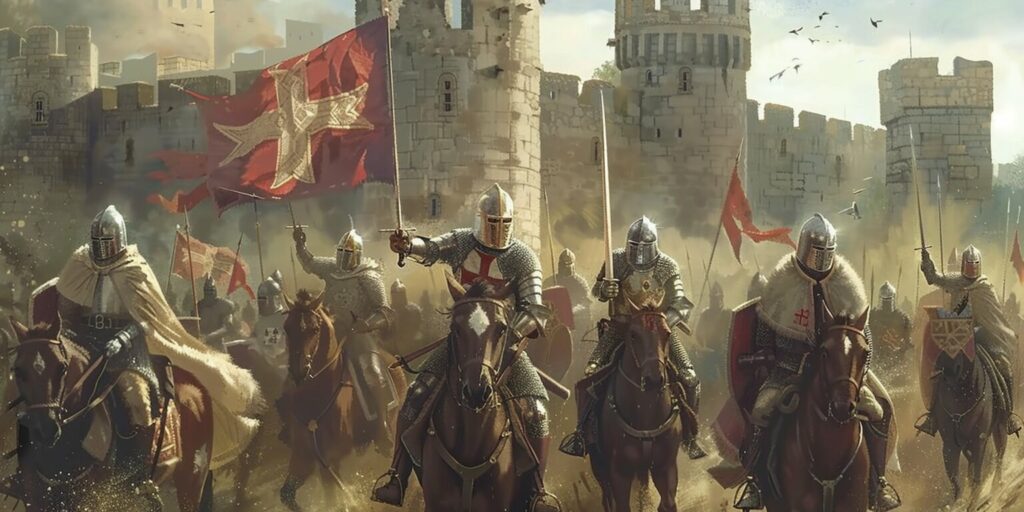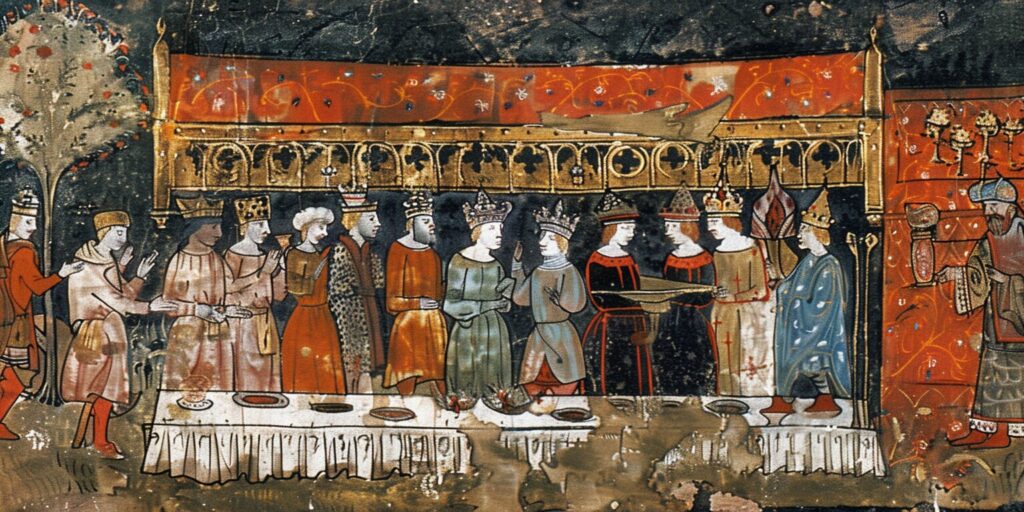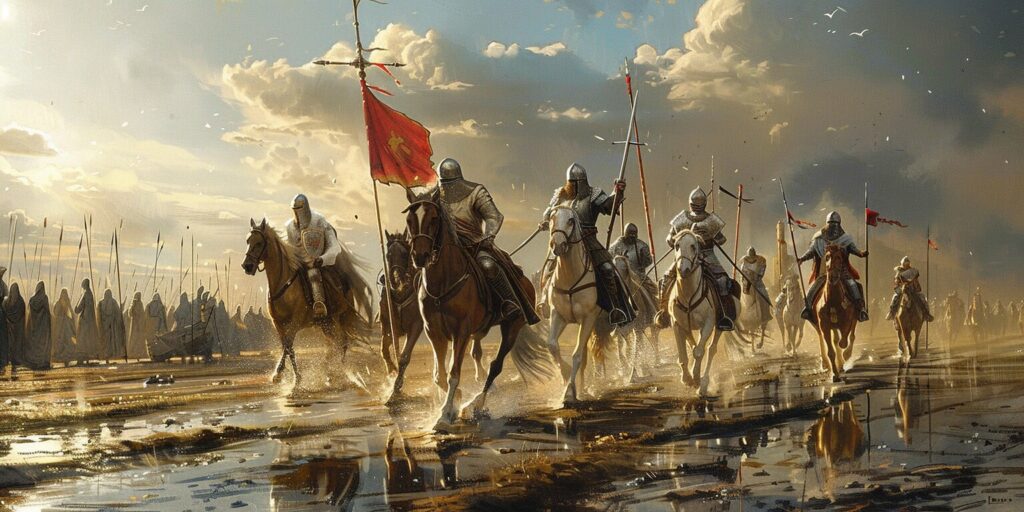The Crusades, a series of holy wars fought between Christian and Muslim forces during the medieval period, impacted various aspects of European society. One significant area of influence was the economy. The economic effects of the Crusades were far-reaching and diverse, shaping trade, finance, and overall economic growth in Europe.
Before discussing the specific economic consequences of the Crusades, it’s crucial to understand the state of trade and commerce in Europe before this period of religious fervor. Medieval trade relied heavily on the Mediterranean as a vital route, with merchants and guilds playing a central role in economic activities.
Medieval Trade Before the Crusades
To understand the economic impact of the Crusades, it is important to examine the state of trade and commerce in Europe before this significant historical event. During the medieval period, trade played a crucial role in the development and growth of European economies.
One of the key factors that shaped medieval commerce was the Mediterranean Sea. It served as a vital trade route connecting Europe, Africa, and Asia, fostering the exchange of goods, ideas, and cultures. Merchants from various regions, including the Byzantine Empire, Muslim lands, and European kingdoms, utilized the Mediterranean as a hub for trade.
The medieval trade network was comprised of merchant guilds, which played a central role in organizing and regulating trade. These guilds were associations of merchants who collaborated to protect their economic interests, maintain quality standards, and establish trade routes. They facilitated the flow of goods and capital, contributing to the economic growth of European cities.
Trade before the Crusades was primarily focused on luxury goods such as spices, silk, and precious metals. These high-value items were in demand throughout Europe and were often obtained through long-distance trade. The exchange of goods was accompanied by the transfer of knowledge and ideas, enriching European society.
Key Features of Medieval Trade:
- A network of trade routes linked Europe to other regions through the Mediterranean Sea.
- Merchant guilds played a crucial role in regulating and organizing trade.
- Luxury goods, including spices and silk, were highly valued and sought after.
- Trade facilitated the exchange of knowledge and ideas, contributing to cultural diffusion.
The medieval commerce before the Crusades laid the foundation for economic growth and development in Europe. It established trade networks, nurtured entrepreneurial spirit, and introduced Europeans to new goods and ideas. These factors would later be amplified and expanded upon as a result of the Crusades’ impact on trade and commerce.
Catalyst for Change: The Crusades and Trade
The Crusades marked a significant turning point in trade patterns and practices, serving as a catalyst for transformative economic implications. The impact of the Crusades on trade routes, the introduction of new goods, and the exchange of cultural and economic ideas cannot be overstated.

First and foremost, the Crusades spurred the expansion of trade routes. As European crusaders journeyed to the Holy Land, they encountered diverse cultures and new trade networks. These interactions facilitated the establishment of new trade routes, connecting distant regions and fostering economic growth.
Moreover, the Crusades introduced new goods to European markets. Crusaders returned with exotic spices, silk, and other luxury items from the East, igniting a demand for these goods among European nobility and sparking a trade boom. This infusion of diverse goods broadened European consumers’ choices and led to the proliferation of specialized merchant guilds.
Merchant Guilds: A Driving Force in the Crusades’ Trade Implications
Merchant guilds played a pivotal role in facilitating trade and enhancing economic prosperity during and after the Crusades. They provided a platform for merchants to collaborate, form partnerships, and negotiate trade agreements. They were also responsible for introducing standardized weights and measures, which streamlined transactions and instilled trust in commercial dealings.
The exchange of cultural and economic ideas was also a significant consequence of the Crusades. Crusaders encountered diverse cultures and traditions during their journeys, exposing them to new knowledge and practices. This exchange of ideas led to the adoption of Arabic numerals, accounting techniques, and innovations in agricultural practices.
The Crusades’ Legacy: A Shifting Economic Landscape
The Crusades had a profound and lasting impact on Europe’s economic development. The economic changes brought about by the Crusades, including the expansion of trade routes, the introduction of new goods, and the exchange of ideas, set the stage for Europe’s emergence as a global economic power. These changes laid the foundation for the Renaissance and the subsequent Age of Exploration.
- Expansion of trade routes
- Introduction of new goods
- Exchange of cultural and economic ideas
By examining the trade implications of the Crusades, we gain insight into the dynamic forces that shaped medieval Europe’s economic landscape. While the Crusades were undoubtedly religious, their economic consequences cannot be overlooked. The legacy of the Crusades in trade and commerce continues to influence our present-day understanding of global economics.
Growth of the European Economy
The Crusades brought about significant economic changes that fueled the growth of European economies and gave rise to new economic systems. These transformations impacted various aspects of society, including banking, urban development, and societal structures.

The Role of Banking
One key factor contributing to the growth of European economies was the establishment of new banking practices during the Crusades. European merchants and knights increasingly relied on financial institutions, such as moneylenders and the emerging Knights Templar, to facilitate trade and finance their expeditions. This led to the development of banking systems and contributed to Europe’s overall economic prosperity.
Rise of Urban Centers
The Crusades also played a pivotal role in the rise of urban centers throughout Europe. As the demand for goods and services increased due to the influx of wealth from the Crusades, towns and cities became vital hubs of economic activity. Urban centers thrived as trade flourished, creating opportunities for artisans, merchants, and skilled laborers. The growth of these urban centers further fueled economic expansion and prosperity.
Impact of Increased Wealth
The influx of wealth from the Crusades profoundly impacted societal structures in Europe. The accumulation of wealth by the nobility and merchant class led to a redistribution of power and influence. This shook the traditional feudal system and paved the way for a more capitalist economy. The newfound wealth resulted in greater social mobility and an emerging middle class, further driving economic growth and innovation.
Financial Innovations and Institutions
The Crusades profoundly impacted the development of financial innovations and institutions during the medieval period. As a result, early banking systems were established, providing a foundation for the growth of credit and the emergence of financial institutions that would shape European economies for centuries to come.
Establishment of Early Banking Systems
One of the notable financial outcomes of the Crusades was the establishment of early banking systems. As European armies embarked on their journeys to the Holy Land, they required secure means to transport and store their wealth. This led to the development of banking practices such as money lending, currency exchange, and the issuance of letters of credit to facilitate trade and finance along the Crusader routes.
Growth of Credit
The Crusades also played a significant role in the growth of credit. Traders and merchants undertaking journeys to the East needed financial support to fund their ventures. As a result, new credit mechanisms, such as partnerships and joint ventures, were introduced, allowing individuals to pool their resources and spread the risk of business ventures. This facilitated the expansion of trade networks and promoted economic growth in Europe.
Emergence of Financial Institutions: The Knights Templar
Perhaps one of the most renowned financial institutions to emerge from the Crusades was the Knights Templar. Originally founded to protect Christian pilgrims traveling to Jerusalem, the Templars quickly evolved into a powerful banking and financial organization. They provided a range of financial services, including loans to European monarchs, secure wealth storage, and issuing letters of credit. The Templars’ reputation for reliability and trustworthiness made them the preferred financial institution of the medieval world.
In conclusion, the Crusades had far-reaching financial outcomes that shaped the economic landscape of medieval Europe. The establishment of early banking systems, the growth of credit, and the emergence of financial institutions like the Knights Templar all contributed to the advancement of trade and finance. These financial innovations and institutions played a pivotal role in fueling economic growth, fostering commerce, and establishing lasting legacies that continue to be studied and debated by historians and scholars today.
Impact on Mediterranean Trade
One of the Crusades’ significant consequences was its impact on Mediterranean trade. The military campaigns resulted in territorial gains and losses and brought about a series of changes that transformed the region’s trading landscape.
Reopening trade routes between Europe and the East was a key development resulting from the Crusades. As European armies ventured into the Holy Land, they established contact with the prosperous cities and markets of the Levant, which had long been hubs of commercial activity. This led to the revival of trade routes that had been disrupted during periods of political instability.
The Crusades also facilitated the introduction of new goods and ideas into Europe. European merchants returning from the Holy Land brought back exotic spices, textiles, and treasures from the East. This influx of goods enriched Europe’s material culture stimulated demand, and created new markets for luxury goods.
Additionally, the Crusades played a crucial role in the establishment of trade fairs and markets. As seasoned traders from the East and West interacted in the cities they encountered along their journey, they exchanged knowledge, ideas, and goods. These interactions led to the emergence of trade fairs and markets, such as the renowned Champagne Fair in France and the Fiera di Sinigaglia in Italy, where merchants from different regions could gather to buy, sell, and negotiate trade agreements.
The impact of the Crusades on Mediterranean trade cannot be overstated. The military campaigns acted as a catalyst for trade, reopening routes, introducing new goods and ideas, and fostering the growth of commercial centers. These developments not only transformed the economic landscape of the medieval period but also laid the foundation for the age of exploration and the later expansion of global trade.
Technological Advances and Knowledge Transfer
The Crusades were a military and religious endeavor and a source of technological advancements and knowledge transfer. These conflicts brought together people from different regions and cultures, leading to the exchange of ideas and innovations. Here are some key aspects:
Agricultural Practices
One significant area where knowledge transfer occurred during the Crusades was agriculture. European Crusaders encountered advanced agricultural techniques practiced in the Middle East, such as the cultivation of crops like citrus fruits, sugar cane, and cotton. They brought back these practices to Europe, expanding the range of crops and leading to improvements in farming methods and productivity.
Scientific Knowledge Exchange
The Crusades facilitated the exchange of scientific knowledge between the East and the West. During their encounters with Arab scholars and philosophers, Crusaders gained access to works of ancient Greek philosophers, such as Aristotle and Plato, which were preserved and translated by Arab scholars. This transfer of knowledge profoundly impacted academic institutions in Europe and contributed to the revival of intellectual pursuits known as the Renaissance.
Spread of Arabic Numerals and Accounting Techniques
Another important contribution of the Crusades was the spread of Arabic numerals and accounting techniques to Europe. Arab traders used a numeral system that was far more advanced than the Roman numerals commonly used in Europe at the time. European merchants adopted the Arabic numeral system, providing greater calculations and efficient record-keeping. This development revolutionized commerce and laid the foundation for modern accounting practices.
In conclusion, the Crusades had unintended consequences beyond their military and religious objectives. They facilitated the exchange of knowledge and technological advancements, resulting in the introduction of new agricultural practices, the dissemination of scientific knowledge, and the adoption of Arabic numerals and accounting techniques. These developments played a crucial role in shaping Europe’s economic and intellectual landscape in the centuries following the Crusades.
Economic Disruptions and Consequences
The Crusades had significant economic ramifications, resulting in various disruptions and consequences that shaped Europe’s economic landscape for centuries to come. These effects encompassed multiple aspects, including inflation, changes in labor patterns, and the redistribution of wealth.
Inflation
One of the key economic disruptions caused by the Crusades was inflation. As European powers invested heavily in financing military campaigns, the increased demand for resources and manpower led to a surge in prices. This inflationary pressure impacted not only the cost of goods and services but also the overall stability of local economies.
Changes in Labor Patterns
The Crusades significantly changed labor patterns in Europe. Many peasants and artisans left their traditional occupations to participate in the holy campaigns, causing labor shortages in various industries. This shift in workforce dynamics had profound effects on agricultural productivity, trade, and economic stability.
- The departure of skilled workers, such as blacksmiths and carpenters, disrupted local economies and hindered the production of essential goods.
- The decrease in agricultural labor resulted in reduced food production and increased reliance on imported goods.
- The need to fill labor gaps led to the emergence of new forms of labor, such as serfdom and indentured servitude.
Redistribution of Wealth
The Crusades also significantly redistributed wealth within European societies. The immense expenses associated with financing the holy campaigns prompted nobles and kings to find new sources of revenue, while merchants and financial institutions took advantage of the increased demand for capital.
- Nobles and monarchs imposed heavy taxes on their subjects to fund the Crusades, leading to a concentration of wealth among the ruling class.
- Merchants and entrepreneurs, spurred by the economic prospects presented by the Crusades, accumulated substantial wealth through trade and financial ventures.
- The establishment of financial institutions, such as the Knights Templar, facilitated the flow of capital and further contributed to the redistribution of wealth.
The long-term impact of these economic disruptions and consequences cannot be overstated. The Crusades shaped Europe’s economic trajectory and paved the way for future economic systems and institutions, such as banking and credit, which played pivotal roles in the continent’s subsequent economic development.
Trade Networks and Cultural Exchange
Trade networks and cultural exchange played a crucial role in shaping the economic effects of the Crusades. As European forces embarked on their expeditions to the Holy Land, they encountered diverse cultures, ideas, and technologies along the way. These encounters sparked a process of exchange and cross-pollination, leading to significant transformations in Europe’s economic landscape.

The Spread of Ideas
One key outcome of the Crusades was the spread of ideas. European crusaders interacting with people from the Middle East discovered new knowledge, philosophies, and scientific advancements. These valuable insights were then brought back to Europe, enriching intellectual, cultural, and economic spheres. Arab innovations in areas such as mathematics, astronomy, and medicine, for example, greatly influenced European scholarship and scientific progress.
The Diffusion of Technology
The Crusades also facilitated the diffusion of technology. Europeans encountered advanced technologies, particularly in agricultural practices, architecture, and military techniques, during their interactions with different cultures. This exposure led to the adoption and adaptation of various technologies in Europe, resulting in improved agricultural productivity, architectural advancements, and more efficient military strategies. These technological transfers directly impacted Europe’s economic development, enhancing productivity and creating new avenues for trade and commerce.
The Importance of Cultural Interaction
Cultural interaction was a driving force behind the economic effects of the Crusades. As Europeans came into contact with diverse societies, they exchanged goods, ideas, cultural practices, and norms. This interaction led to the diversification and expansion of Europe’s economic activities. Foreign techniques and manufacturing methods were incorporated into European industries, creating a more vibrant and dynamic economic landscape. Moreover, the fusion of different cultural traditions helped foster a spirit of entrepreneurship and innovation, fueling economic growth.
Ultimately, trade networks and cultural exchange played a vital role in shaping the economic effects of the Crusades. The spread of ideas, the diffusion of technology, and the importance of cultural interaction all contributed to significant transformations in Europe’s economic landscape. By embracing these cross-cultural exchanges, Europe experienced unprecedented growth and development, laying the foundations for its future economic prosperity.
Conclusion
The economic effects of the Crusades had a profound and lasting impact on the trade, finance, and growth of European economies. The Crusades acted as a catalyst for change, leading to the expansion of trade routes, the introduction of new goods, and the exchange of cultural and economic ideas. This resulted in significant growth and development across Europe.
Furthermore, the Crusades gave rise to financial innovations and institutions, including early banking systems, the growth of credit, and the establishment of financial institutions such as the Knights Templar. These developments fostered economic stability and paved the way for future financial systems.
While the Crusades brought about positive changes, they also caused disruptions and consequences. Inflation, changes in labor patterns, and the redistribution of wealth are some of the economic challenges that Europe faced during this period. However, these disruptions ultimately contributed to the long-term economic development of the continent.
In conclusion, the economic effects of the Crusades were multifaceted and far-reaching. They transformed trade and finance, stimulated growth and innovation, and created both opportunities and challenges. The ongoing scholarly debate surrounding the economic impact of the Crusades highlights the continued fascination and importance of understanding this fascinating chapter in history.

